Table of Contents
Buying a box spring as an extra accessory for your bedroom can be tiring and budget-consuming. An additional box spring on top of a mattress and bed frame can take up space and make setting up a bedroom more laborious.
You can easily skip the hassle if you look for mattresses without box springs, saving time and money and giving your bedroom a contemporary, minimalist look.
This article will look at our top 5 best mattresses without box spring, and help you decide what type of mattress is best suited for your home.
Let’s start.
Quick Overview:
- Best Overall – Editor’s Choice – Puffy Mattress
- Runner Up – PlushBeds Botanical Bliss Organic Latex Mattress
- Best Natural Option – Eco Terra Hybrid Latex Mattress
- Best Value – Latex for Less Hybrid Latex Mattress
- Best for Hot Sleepers – Eight Sleep Pod 3 Mattress
Our Review of the 5 Best Mattresses Without Box Spring
Best Overall — Editor’s Choice — Puffy Mattress
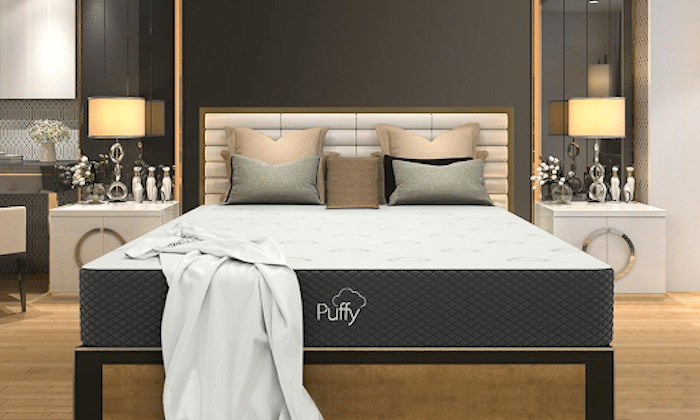
Highlights:
- The Cooling Cloud foam layer gives enhanced pressure relief, cradling your body deeply.
- The high-density foam core provides enough support to keep the spine and body even and aligned for tension-free sleep.
- Has an easy-to-remove cover that can be removed in under 10 seconds, making cleaning day a breeze.
The Puffy is my editor’s choice for the best mattress without box spring due to its excellent sinkage, pressure relief, and motion isolation. The Puffy offers some of the most contouring sinkages I’ve tested, measuring about 2.5 inches deep. I noticed how the top layers compressed substantially, and I was well-molded in a traditional, pressure-relieving memory foam feel. This model is 0.59 inches more sinking than the PlushBeds Botanical Bliss, an all-latex model, making the Puffy the better choice for sleepers who want a conforming, enveloping feel.
On top of having excellent sinkage, the Puffy also offers excellent pressure relief from its slow bounce-back. Having a slow bounce-back means the Puffy uses high-density foam, a mark of a high-quality mattress. From my tests, it took the Puffy 1.7 seconds to bounce back from compressions. I could enjoy slow-sinking cradling that slowly adapted to my curves but didn’t restrict my movement much. The Puffy responded 1 second slower than the PlushBeds Botanical Bliss. That means the Puffy is better for sleepers looking for a traditional, slow-adaptive memory foam feel.
Motion isolation is a critical factor for a mattress without a box spring, as this ensures you aren’t disturbed if you have a restless partner. Too often, I find mattresses with box springs, like innerspring mattresses, have too much bounce and motion transfer. Fortunately, the Puffy’s all-foam design works independently of a box spring. From my tests, it absorbed motion up to 2.5 inches from my glass of water. This was enough isolation power that my partner could only feel muted shuffling as I got in and out of bed and couldn’t notice when I was tossing and turning. Comparatively, the Puffy had better motion isolation by 3.5 inches than the PlushBeds Botanical Bliss, making the Puffy better suited for restless couples.
Based on Our Tests
In light of my review, I found the Puffy to be conforming and delightfully pressure-relieving. I was without tension while on my side, and my shoulder and hips weren’t pinched while lying in the enveloping layers.
Recommended For:
- Fans of a traditional memory foam feel. The Puffy offers a deep, cradling sinkage that slowly adapts, relieving pressure with a traditional foam feel;
- Sleepers who enjoy an easy-clean solution. The Puffy comes with a zippable cover that can be easily removed, helping keep your room clean;
- Restless partners. The Puffy has minimal motion transfer, helping light sleepers rest with fewer disturbances.
Pros:
- Excellent motion isolation for undisturbed sleep;
- Excellent pressure relief due to its deep sinkage;
- Easy-to-remove cover.
Cons:
- Too slow-moving for fast movements;
- Too soft for heavier stomach sleepers.
Check Current Price on Puffy.com
Runner Up — PlushBeds Botanical Bliss Organic Latex Mattress
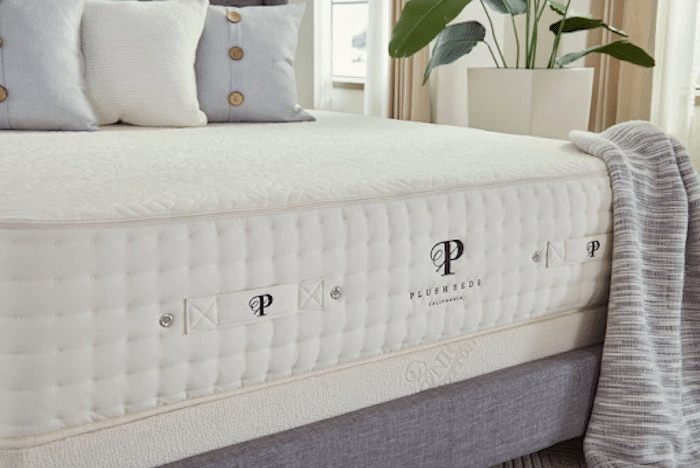
Highlights:
- The supportive comfort layers ensure excellent spinal support for tension relief.
- The responsive latex layers give your body a slight spring, similar to mattresses with box springs.
- Comes with durable side handles to ensure easy maneuverability of the mattress.
The PlushBeds Botanical Bliss Organic Latex Mattress is my runner-up for some of the best mattresses that don’t need box springs, thanks to its natural springiness, breathable construction, and durable edges.
Mattresses without a box spring sometimes struggle with delivering the adequate bounce that a box spring provides. Fortunately, the PlushBeds Botanical Bliss is sufficiently bouncy due to its all-latex layers. I felt buoyant and free to move across the width of the bed during my tests. I also recorded a bounce level of 9.21 inches, which is relatively high. This is just under the recorded bounce of the Eco Terra, with a difference of 0.7 inches. That means both are suitable for sleepers who want ease of movement for their mattress without a box spring.
Along with excellent bounce, the PlushBeds Botanical Bliss also sleeps cool. Its breathable cotton, wool, and perforated latex layers help keep heat from building up. The wool also ensures your body doesn’t experience temperature fluctuations. According to my review, the PlushBeds Botanical Bliss had a temperature of 85 degrees Fahrenheit, and I enjoyed a cool, soft sleep without any night sweats. This model had slightly better temperature regulation than the Eco Terra, likely due to the PlushBeds’ all-latex design which actively doesn’t retain heat. The PlushBeds Botanical Bliss was 3.9 degrees cooler than the Eco Terra, making it the better option for sleepers sensitive to temperature changes.
In addition to a pleasantly cool sleep, the PlushBeds Botanical Bliss also offers durable edges. This can make getting in and out of bed easier and keep the edges safe if you prefer lying near them. During my review, I measured the edges with a sinkage of around 3.7 inches. This is well within the maximum depth of 4 inches I look for, and I was stable without the risk of falling out while on the edge.
The latex in the PlushBeds Botanical Bliss reacted better to compressions than the foam layers in the Eight Sleep Pod 3 by a considerable amount. I recorded a difference of 0.6 inches, meaning the PlushBeds Botanical Bliss is better for sleepers who want stable edges for peace of mind.
Based on Our Tests
In light of my tests, I was most comfortable on my back. The latex layers kept me buoyant and helped my hips stay in line with my spine and neck, and I could easily switch sleeping positions.
Recommended For:
- Active couples. The PlushBeds Botanical Bliss uses responsive latex with excellent bounce and edge support, which can help with fast movements;
- Sleepers who enjoy a modern, unrestricted feel. The PlushBeds Botanical Bliss’s use of latex keeps you buoyant in bed, switching positions effortlessly;
- Sleepers who use the entire width of their bed. The PlushBeds Botanical Bliss offers durable and reliable edge support so you won’t feel like you’ll fall off.
Pros:
- Excellent edge support for stable sitting;
- Excellent, quick, responsive layers for ease of movement;
- Good cooling ability for restful sleep.
Cons:
- Too bouncy to isolate most motion from a restless partner;
- Slightly expensive price tag.
Check Current Price on PlushBeds.com
Best Natural Option — Eco Terra Hybrid Latex Mattress
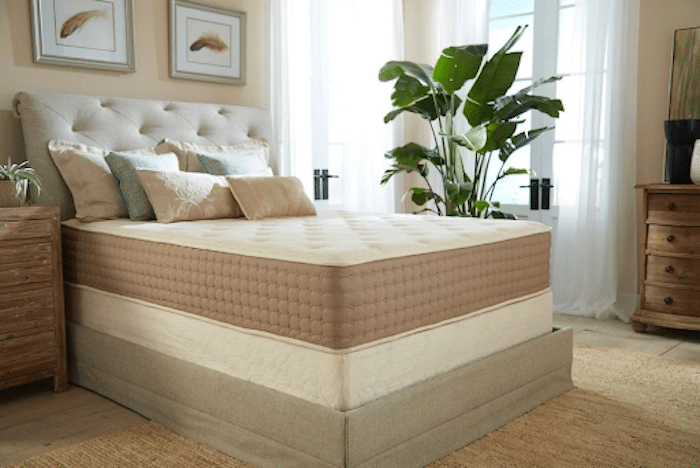
Highlights:
- No dyes or chemicals within this mattress make the Eco Terra a non-toxic option that is safe for children.
- The use of organic wool helps keep your temperature neutral and even, without fluctuations throughout the night.
- The latex layer over coils helps keep you buoyant and supported for springy ease of movement.
The Eco Terra Hybrid Latex Mattress is my best natural mattress without a box spring due to its chemical-free construction, excellent bounce, and quick response time. Sleepers who are eco-conscious will enjoy everything about the Eco Terra. It doesn’t include chemical foams or dyes, like the Eight Sleep. Its cover and fillings are made of organically sourced cotton, wool, and latex. Organic means no off-gassing, which I confirmed when testing this mattress. It didn’t have a ‘new mattress’ smell, just a refreshing cotton scent.
Comparably, the Eight Sleep Pod 3, an all-foam model, took at least 24 hours longer to off-gas. That means the Eco Terra is optimal for a non-toxic, no-chemical mattress that doesn’t need a box spring.
Mattresses without a box spring need to still be responsive and springy, which the Eco Terra accomplishes well. Active couples especially can use its mix of bouncy latex and coils for fast movement. When reviewing this mattress, I recorded a bounce of 9.91 inches, which is high enough that I noticed a slight spring every time I got in or out of bed. This is 0.7 inches more than the PlushBeds Botanical Bliss, meaning both have similar unrestrictive bounce.
To add to the Eco Terra’s springiness is its responsive, organic latex layer, which is 3 inches thick and sits over the coils. From my tests, this layer, coupled with the soft cotton and wool top, recovered from impressions after just 0.3 seconds. I could switch from my side to my stomach with minimal effort and didn’t feel restricted or ‘stuck’ in the mattress. The Eco Terra was 0.1 seconds faster than the Eight Sleep Pod 3, which means both respond similarly to impressions, despite the Eight Sleep being an all-foam model.
Based on Our Tests
Through my comprehensive testing, I found the buoyancy of the latex kept me light and free to move around while still cushioning my pressure points. The coils below provided needed support, and I was well-cradled and comfortable.
Recommended For:
- Hot sleepers. The Eco Terra’s use of breathable latex, cotton, and coils ensures a high airflow, helping hot sleepers stay cool;
- Sleepers who prefer a responsive feel. The Eco Terra has a responsive, thick latex layer over coils, ensuring a buoyant, responsive feel whenever you shift positions;
- Eco-conscious sleepers. The Eco Terra uses all-natural materials without chemicals or dyes, making it safe for children and ideal for eco-conscious shoppers.
Pros:
- Excellent ease of movement;
- Excellent chemical-free smell;
- Good, all-natural cooling qualities.
Cons:
- Too soft for heavier stomach sleepers;
- Has a slightly pricey price tag.
Check Current Price on EcoTerraBeds.com
Best Value — Latex for Less Hybrid Latex Mattress
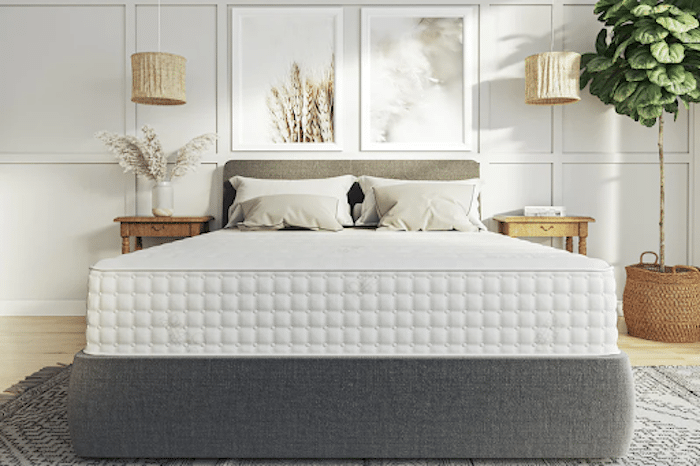
Highlights:
- The competitive price point makes this mattress an excellent option for sleepers who want a latex feel to their mattress without a box spring.
- The latex layer is supportive and cushioning, spreading your weight over a wider area for good pressure relief.
- The coils help keep your weight buoyant and even, especially on the edge, so there’s no risk of falling off.
The Latex for Less Hybrid Latex Mattress is my best value mattress without a box spring due to its competitive pricing, ability to disperse heat and ensure ease of movement. The Latex for Less Hybrid is priced $700 cheaper than the PlushBeds Botanical Bliss, and $3446 cheaper than the Eight Sleep Pod 3, an intelligent all-foam model. Despite these price differences, the Latex for Less Hybrid offers comparable ease of movement, comfort, and cool slumber that suits a mattress without a box spring.
Along with its excellent price point, the Latex for Less Hybrid can disperse heat reasonably well, thanks to its latex and coils. When testing this model, I recorded a temperature of 89.7 degrees Fahrenheit. The latex kept heat from building up, and I enjoyed temperature-neutral slumber. This is similar to the Eco Terra, where the Latex for Less Hybrid was hotter by just 0.8 degrees. That means both models suit hot sleepers looking for relief from night sweats.
Mattresses without a box spring need something else to provide bounce, which the Latex for Less Hybrid addresses with its 3 inches of spongy latex, and robust coils. In light of my tests, the Latex for Less Hybrid took only 0.3 seconds to bounce back from impressions. This was quick enough that I could feel the spongy buoyancy of the latex, but I could easily switch positions and move unrestricted. This is the same reaction speed as the Eco Terra of 0.3 seconds, which makes both models an excellent option for sleepers who want responsive ease of movement.
Based on Our Tests
I have found from testing the Latex for Less Hybrid that it’s most comfortable when I’m on my back. The latex offers spongy, cushioning support that relieves pressure and supports my spine for pain-free sleep.
Recommended For:
- Hot sleepers. The Latex for Less Hybrid is breathable, drawing heat away through its latex layers and coils, keeping hot sleepers comfortable;
- Sleepers on a budget. The Latex for Less Hybrid is affordable, ensuring luxury materials like latex are more accessible to sleepers on a budget who want a mattress without a box spring;
- Sleepers who prefer firm support. The Latex for Less Hybrid offers a supportive surface of latex and coils, keeping the spine neutral and tension-free.
Pros:
- Excellent support to keep the spine aligned;
- Excellent, cost-effective price for sleepers on a tight budget;
- Good cooling qualities.
Cons:
- Too firm for lightweight side sleepers
- Too soft for heavier stomach sleepers over 230 pounds
Check Current Price on LatexForLess.com
Best for Hot Sleepers — Eight Sleep Pod 3 Mattress
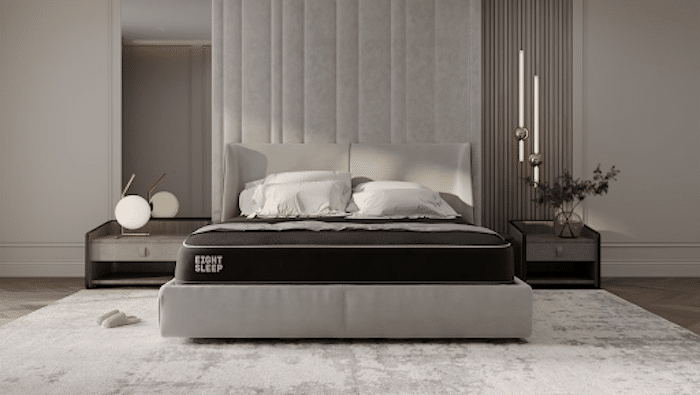
Highlights:
- Highly intelligent app that tracks sleep, adjusting your temperature throughout the night for undisturbed sleep.
- The robust cooling system uses water to adjust your temperature and draw heat out, keeping you refreshed and cool.
- The Airflow foam layer conforms to your body, ensuring you feel comfortable and your muscles are tension-free.
The Eight Sleep Pod 3 is my best mattress without box spring for hot sleepers due to its innovative cooling technology, its intelligent app, and cushioning, modern foam feel.
Often foam mattresses struggle to stay cool, but the Eight Sleep Pod 3 has a unique way around this. It uses a water-based cooling system that flows through the top layer of the mattress, adjusting the temperature and drawing out heat continuously throughout the night. From my tests, I recorded a temperature of 87.9 degrees Fahrenheit, which is exceptionally good for an all-foam mattress. I felt calm and cool and never experienced a point where I felt my heat building up during the night.
This model is 1 degree cooler than the Eco Terra, showing the effectiveness of the Eight Sleep Pod 3’s cooling system. That means the Eight Sleep is better suited for hot sleepers sensitive to temperature fluctuations.
The Eight Sleep Pod 3 also boasts an intelligent sleep app. This is built into the mattress’s cover, tracking movements like switching positions or getting out of bed. I saw how it built an analysis of my sleep behaviors, offering insight into how I could improve. Currently, no other mattress has a built-in sleep analysis that performs as seamlessly as the Eight Sleep.
The Eight Sleep Pod 3 provides a modern feel, despite having an all-foam construction. Its layers are made to be springy and unrestrictive, along with a tout cover. I noticed the foam didn’t conform as much as it normally would due to this cover, but it also helped make switching positions effortless. From my tests, I recorded a recovery from compressions after just 0.4 seconds, making the foam very fast-acting. Compared to the Puffy, the Eight Sleep Pod 3 is better for ease of movement, reacting faster to compressions by 1.3 seconds.
Based on Our Tests
As per my review, the Eight Sleep Pod 3 had excellent cradling and support. My body was comfortable and evenly supported, with a latex-like contour that focused more on support and less on a memory foam-like hug.
Recommended For:
- Sleepers who want a technology-smart bed. The Eight Sleep Pod 3 offers an insightful sleep analysis app that tracks and helps improve sleep over time, helping you get your best rest;
- Hot sleepers. The Eight Sleep Pod 3’s water-based cooling system draws away heat dynamically so hot sleepers stay cool;
- Sleepers who prefer a latex-like feel. The Eight Sleep Pod 3’s unique cover and top layer are slightly touted, offering support while providing slightly less contouring, similar to latex.
Pros:
- Excellent cooling technology for cool sleep;
- Excellent response time for ease of movement;
- Good sinkage for even comfort and pressure relief.
Cons:
- Slightly expensive price tag;
- To soft for heavier sleepers who want edge support.
Check Current Price on EightSleep.com
How To Choose a Mattress Without a Box Spring?
To choose a top-rated mattress without box spring, you have to look at what type of mattress you want, if it’s compatible without a box spring, and if it’s high enough quality to last a long time on a foundation or platform bed.
Typically, the best mattresses, like the Puffy, contour with extra pressure relief and explicitly state what type of base they are made for. In the case of Puffy, they are made for all types of foundations and platform bases, but not for box springs.
It can be slightly challenging to find alternatives to box spring mattresses, as 2018 Statista reported that box spring foundations were considered the most popular by US sleepers (1). Box springs took a total of 35%, with slatted bed frames and platform foundations coming in second place at 22%. Adjustable beds were least preferred at 21%. This is why it’s important to know what type of mattress you’re getting and that it’s compatible with all foundation types, like slatted bed frames.
However, the mattress industry is growing and is expected to double in value in the next 7 years (2). That means options for sleepers who prefer mattresses without box springs will only increase as time passes. This is especially true considering the continued growth of the online mattress space. As mattress in a box brands continue to innovate and with the increasing appeal of ordering a mattress directly to your door, the average shopper looking to avoid box springs will undoubtedly have a much wider variety of mattresses to choose from in the near future.
What Is The Difference Between a Box Spring And a Foundation?
The main difference between a box spring and a foundation is the support level each provides and which mattresses they are designed for. A box spring has more give than a foundation, with a softer feel meant to offset the firmness of an innerspring mattress.
On the other hand, a foundation has firmer support to ensure a mattress doesn’t allow for too much sinkage and has a stable base.
A box spring cannot be used with certain types of mattresses, like memory foam mattresses, because it’s too soft. This softness would cause the bed to provide inadequate support, and the sleepers’ hips would sink too deeply.
What Types Of Mattresses Don’t Need a Box Spring?
The most common types of mattresses that don’t need a box spring include memory foam, latex, and hybrids that use a mix of foam or latex components.
Memory foam already provides enough cushioning and softness that a box spring would. So, putting the two together would make the memory foam mattress unsupportive. That’s why memory foam feels so pressure-relieving and supportive on a firm base, like slats.
Latex is cushioning like memory foam, except with more bounce and generalized, spongy contour. Latex’s inherent sponginess is too soft for a box spring, but is perfect for a platform bed or foundation.
Hybrids are for sleepers who still want the feel of coils from innerspring mattresses but don’t want a box spring. Hybrids utilize either foam or latex comfort layers over a coil base. This combination feels supportive and traditional on a firm foundation or platform bed.
What Does a Mattress Without a Box Spring Need?
Frequently, top-rated mattresses without box spring need a balanced mix of pressure relief, support, robust edges, and comfort. This ensures you, as the sleeper, are tension-free, feel no pressure build-up, and are evenly supported while resting.
Good Pressure Relief
The best mattresses that don’t need box springs often use soft upper layers, like the Puffy’s thick memory foam layers. This helps spread your weight over a more expansive space, reducing pressure build-up and minimizing muscle tension.
Even Support For Your Spine
Mattresses without a box spring need a strong core made up of foam, latex, or hybrid coils to keep your body evenly supported. This support ensures your hips don’t sink too deeply and keep your spine straight and healthy.
Reliable Edge Support
The best mattresses without box spring also need reliable edges so you can sit comfortably without any risk of falling out or slipping. This also ensures you can use the entire width of a bed and even lie along the perimeter comfortably.
Excellent Comfort
Mattresses that don’t use a box spring should provide exceptional comfort with their sinkage, response rate, and ability to create a ‘weightless’ feeling. Decent sinkage of around 2 inches contributes to a high level of comfort. A response rate between 0.5-1.5 seconds also helps create a contouring, slow-adaptive pressure relief feel for excellent comfort.
FAQ:
Is it good to have a mattress without a box spring?
Yes, it is okay to have a mattress without a box spring if you have some type of support between your mattress and the bed frame. This support can be slats, a foundation, or a platform.
What sleeping option does not need a box spring?
A platform bed, or a bed frame that uses a foundation, be it wooden or metal slats, or a solid base, are all sleeping options that don’t need a box spring. They provide enough support and spring for a mattress, so you don’t need to buy an extra accessory.
Conclusion
Achieving a space-saving look and saving money and time doesn’t have to be a challenge. Knowing what makes a good mattress without a box spring, like comfort, support, and stable edges, you can decide which mattress suits your home best.
In my opinion, the best mattress without box spring is the Puffy due to its excellent comfort, cradling sinkage, and slow-adaptive pressure relief. From my tests, I found the 2.5-inch sinkage enveloping, and it slowly molded to my body, taking off the pressure and relieving my muscles of tension. The Puffy is the best choice for sleepers with restless partners, as this model absorbs a high amount of motion for undisturbed sleep.
What are your experiences when choosing mattresses without a box spring? Let us know in the comments below!
Photo by Ty Carlson on Unsplash


